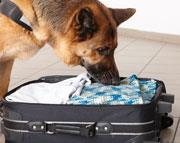Simon Cotton takes a look at those compounds that find themselves in the news or relate to our everyday lives.
We're hearing a lot about Improvised Explosive Devices (IEDs) these days but what are they made from and how can we detect them?
All about TNT?
We're not always looking for trinitrotritoluene (TNT). A lot of the time sniffer dogs searching for landmines are actually detecting other molecules, like DNT (dinitrotoluene) and DNB (dinitrobenzene). DNTs are a regular impurity in TNT, which arise because some of the toluene molecules were not completely nitrated. Because it is a lighter molecule, the vapour pressure of DNT at room temperature is about 20 times that of TNT, so it's much more detectable.

Do all explosives contain nitro- compounds?
No. Plastic explosive doesn't, but in many countries the law requires that all plastic explosives contain a detection tag that can be 'smelt.' In the US, this molecule is 2,3-dimethyl-2,3-dinitrobutane (DMNB), which sniffer dogs can easily detect.
Instrumental methods

Although sniffer dogs are still widely used to detect explosives in war zones, instruments might one day completely replace them. Instruments can pick up a wider range of chemicals than dogs, plus they do not suffer from fatigue. Some scientists are trying to make very sensitive 'artificial noses' to sniff for traces of explosive chemical vapours at the parts per trillion (ppt) level.
In one such device, developed at the Massachusetts Institute of Technology, US, a stream of air is sucked up and passed over the sensor; the nitroaromatics bind to a polymeric fluorescent material and quench its fluorescence; when it stops emitting light, that means that there is explosive material around.
William Trogler's group at the University of California, San Diego, US, have synthesised blue-emitting copolymers whose fluorescence is quenched by nitro explosives, and can distinguish between aromatic nitro compounds (like TNT) and nitrate esters such as PETN. Trogler's team have also devised thin films of metal phthalocyanine complexes to detect traces of hydrogen peroxide present in TATP, formed by natural breakdown. Scientists at Tel-Aviv University in Israel have made a dendimeric polymer that is broken down by traces of H2O2, generating fluorescent reporter molecules that can be detected.
Sloppy bomb manufacturers may also leave traces of explosive on the surface of devices and instrumental methods are being investigated to detect explosives at 'stand-off distances', that is, metres away from the suspected device. At present, though, none of the methods that have been devised are sensitive enough to be used in portable devices in the field.






No comments yet